Recollections of growing up Schmitz
Sun, 10/27/2024
By Gayle Fulton
Emma & Ferdinand Schmitz certainly contributed much to the Alki and West Seattle open spaces. The family came from the beautiful Black Forest area of Germany. Emma and Ferdinand knew each other as teen sweethearts. Ferdinand emigrated to the US. and spent time in Baltimore, St. Louis, and Pomona, California before coming to Seattle in the late 1800’s. He made a trip to Germany where he proposed, and this picture is their engagement picture.
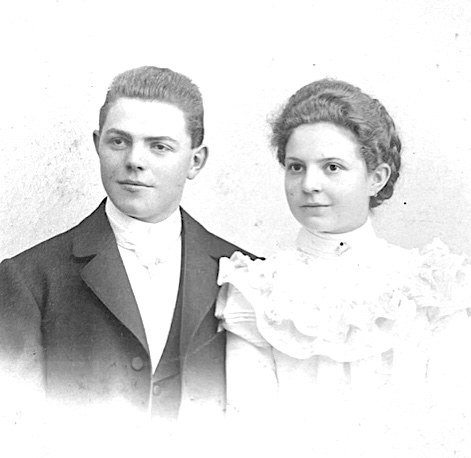
Ferdinand and Emma Schmitz upon their engagement.
I think he did not want to send for his sweetheart until he had something to offer her – but it was a couple years before he could provide a lovely home in Seattle on 12th and Pike Street with space for a garden that he knew she would want. The 1900 Census shows them living in this Pine Street home with children Deitrich, Henry, Emma, and Henrietta, Eugen, and Helmuth (their niece and nephews from Germany) and a maid.
This ability to plan long-range to achieve their goals for their family and others were central to both their characters and family traditions. I imagine both preparing themselves for their future lives together in the U.S. in their own way. Emma learning about gardening, canning, studying English and so forth as Ferdinand began as a baker, then a butler, then co-owner of the Butler Hotel with his dear and good friend Deitrich Hamm during the Gold Rush years. The entire time he was interested in real estate and was always on the lookout for opportunities.
Ferdinand Schmitz and Deitrich Hamm met on the ship from Germany to the U.S. and were lifelong friends. They formed a real estate company Hamm & Schmitz and had the restaurant- bar called the Rathskellar in Seattle, which I believe was destroyed by the Seattle fire. They later began running the Butler Hotel from 1893-1903. It was the favored hostelry of those who returned from the Yukon Gold Rush. After the Seattle fire of 1889, it was re-built in brick and two more stories were added in 1903. It was not only the center of the city’s social life, hosting guests including William Jennings Bryan, William Howard Taft and James J. Hill, but also was the meeting place of the Seattle City Council.
In the middle of all this, in 1896 Ferdinand’s brother, Karl, passed away in Duisburg, Germany and a year later so did Karl’s wife, orphaning six children. Emma sent for the six and Ferdinand and Emma took all of them under their wing, housing 5 of them until maturity. Their ages ranged from 19-6.
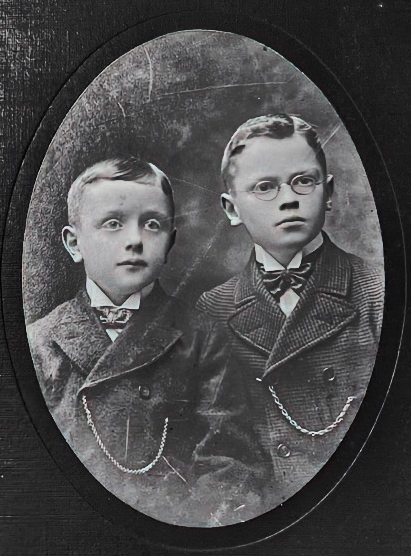
Helmuth and Eugen at ages 6 and 8 prior to leaving Germany.
One of these children was my grandfather, Eugen. The older brother Karl was believed to have been involved in the Rathskellar, but never lived in West Seattle. The oldest daughter, Henrietta, passed away in Seattle before the West Seattle home was built.
The family used to camp in West Seattle and later built a small cabin on the property where their youngest son, Ferdinand, was born.
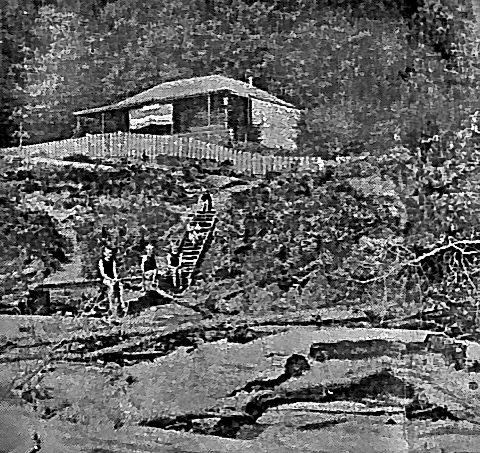
The original cabin on Beach Drive before Sans Souci, the home was built.
The children in the picture are most likely Deitrich, Emmy, Hedwig, Eugen and Henry.
Ferdinand served on the City Council and was instrumental in getting West Seattle annexed to the city. Additionally, he served on the Parks Commission during the time that Olmstead brothers were hired to formulate a city parks plan. He was the first councilman from West Seattle after it was annexed and used a lantern to light his way from his home to the ferry landing at Duwamish Head to get to the council meeting. When he went to the Council meetings, he would put the lantern on the table to impress his colleagues that West Seattle was still unlighted. Finally, they got tired of looking at that lantern!
The home built in West Seattle, known as Sans Souci (with a lovely yacht of the same name) was completed in 1905 and the 1910 Census lists three of their own children, four of the German nieces and nephews and one maid living at Sans Souci.
There’s an article interview with Ferdinand Schmitz in his beautiful Bavarian style home on Beach Drive where he’s sitting in front of the fireplace with the motto “Do it Now” carved into it.
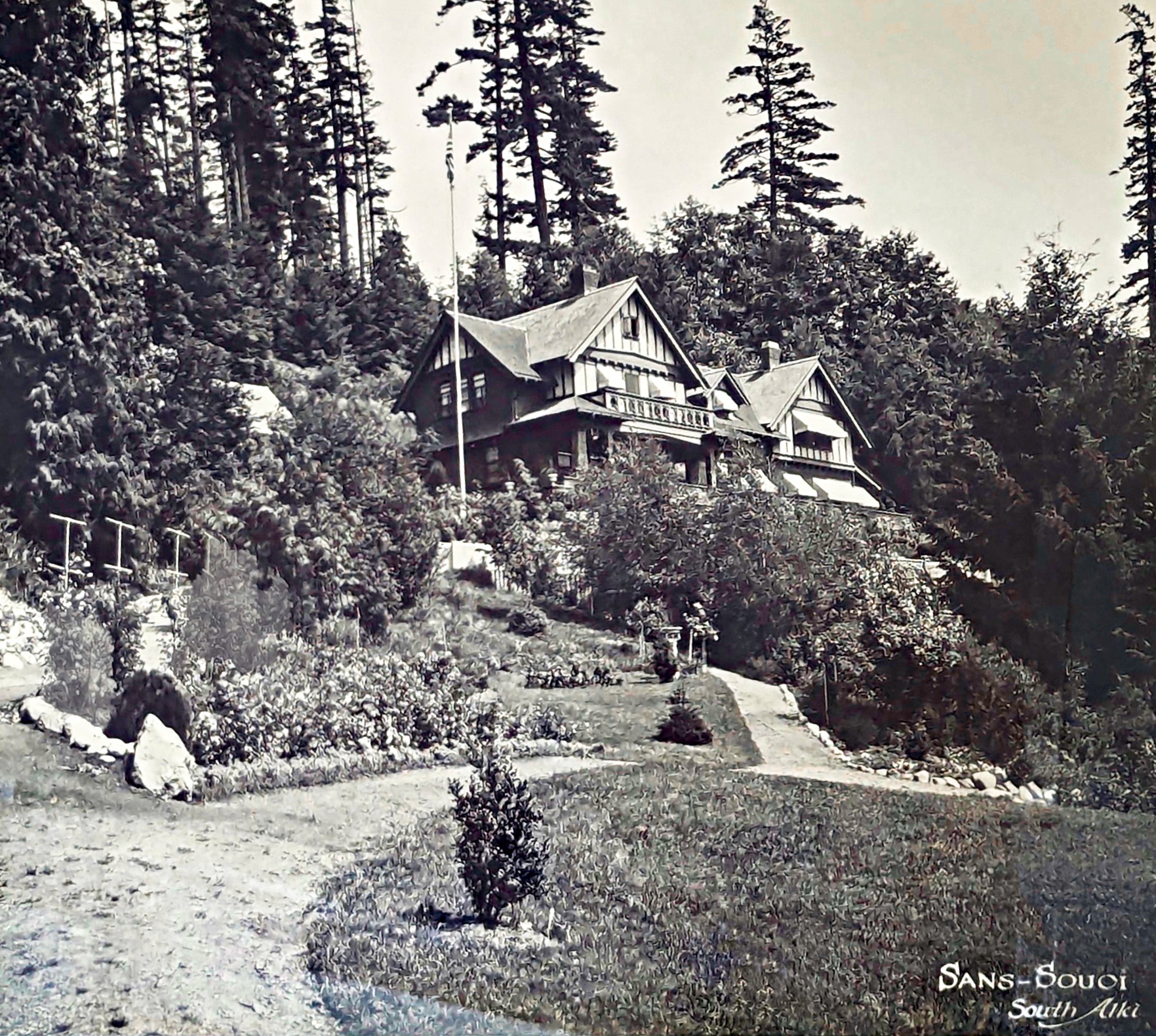
Sans Souci, the 17 room German style home built by Ferdinand Schmitz on Beach Drive.
This is the home he and his wife created from nothing on the beach in West Seattle. By the time Emma passed, she could look out to the Sound, two of their four (Emma and Dietrich) children’s homes line up on the driveway to the north of the home. Lined up on the South side of their home are the homes of one of those children, Eugen’s widow and daughter, JoAn Schmitz Fulton. At the top of the hill behind the house is the home their youngest son, Ferdinand and wife, Margaret, parents of the twins Patsy Schmitz Carpenter and Nancy Schmitz Wilson built their home in about 1955.
Ferdinand passed in 1942 and Emma passed in 1959, but not before she bequeathed the Emma Schmitz memorial overlook property to the City which became the Emma Schmitz Memorial Park. She and her husband watched the development of Alki and Beach Drive and saw it get so developed that it was difficult to catch a glimpse of the Sound and mountains. She wanted to provide a place for the public to have the benefits of a beach front.
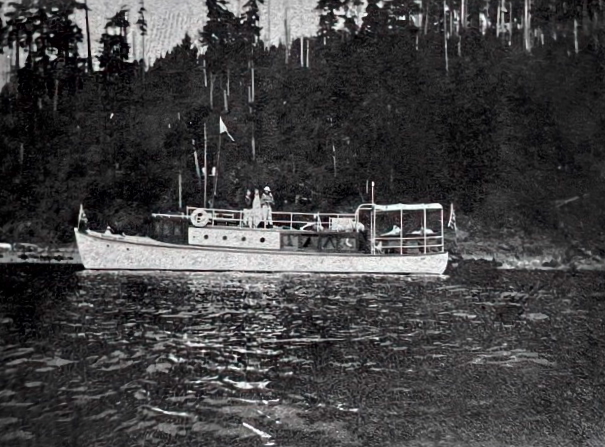
The Sans Souci boat the family used for family outings. The first of two.
That area was originally used for docking their boat, the Sans Souci and Sans Souci II, in which my grandfather as Skipper and the entire family spent many hours cruising the Sound and Hood Canal in the early decades of the 1900’s
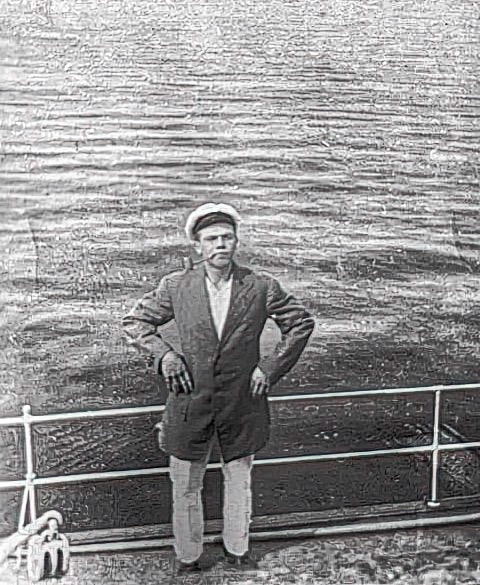
Eugen my grandfather was the Skipper of the Sans Souci
She also gave a large tract of land to her son Ferdinand, who developed Schmitz Estates off Genesee Street nearby. I was also told by my mother that Ferdinand Schmitz was instrumental in getting zoning passed which would not permit any multi-residential buildings over two stories south of their property on Beach Drive down to Lowman Beach Park.
It’s Emma and Ferdinand’s generosity of spirit as well as the terrific “can do” attitude that helped shape the Alki and Beach Drive area we know today. Not only Schmitz Park, Mee Kwa Mooks, Emma Schmitz memorial and the Schmitz estates development, but the 4 square blocks of development between the homestead and Jacobsen Road that were developed for sale specifically for veterans returning from the war and also gifted to the family by Emma & Ferdinand. They were founding members of Alki Church and may have donated land for that. He was influential on the layout and especially the tree planting at the Hiawatha Field House on California Avenue near West Seattle High School. It’s important to know that his influence on the Parks Commission during his elected years was instrumental in developing open and green spaces in West Seattle reminiscent of his homeland and the Black Forest nearby. He encouraged the City Council to bring electricity to West Seattle. There was no electricity when the home was built in 1905. It was only one of only four homes on Alki according to a newspaper interview with Ferdinand in 1938 when he was 77 years old.
And – back to those children who were taken in when their parents in Germany died- because I think this REALLY speaks to their generosity and commitment to family. Four of them lived at that 17-room San Souci, my grandfather, Eugen, and his brother Helmuth, sisters Hedwig and Meta.
Helmuth excelled in naval engineering and while working at the Lake Washington Shipyards became the Architect of the Kalakala ferry, which later received a National Historical Register rating. The ferry operated between Seattle and Bremerton from 1935-1967 and was well known as an iconic ferry. It was also featured in advertising for the World’s Fair in Seattle in 1962. He had two daughters and has many grandchildren and progeny in Southern California.
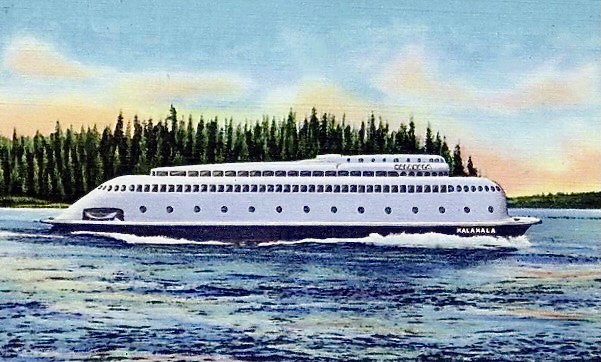
The Kalakala ferry that sailed on Puget Sound from 1935 to 1967.
Hedwig and Meta stayed in the home and helped run the household for all 11 years returning one time to Germany when Hedwig became engaged to her sweetheart. They were engaged for 6 years! Meta and Hedwig then returned together finally to Germany JUST before WWI. They were on the LAST boat to leave the U.S. for Germany. She was well-known to American soldiers who often spent R&R with her in Duisburg because they knew she spoke English and had lived in the U.S. for many years. Hedwig and her husband, Louis and had a family in Germany. Hedwig and her husband visited Seattle in the 60’s to much celebration of the family. Helmuth also returned from Hawaii for that reunion. There grandchildren and great-grandchildren are still in Germany and we correspond.
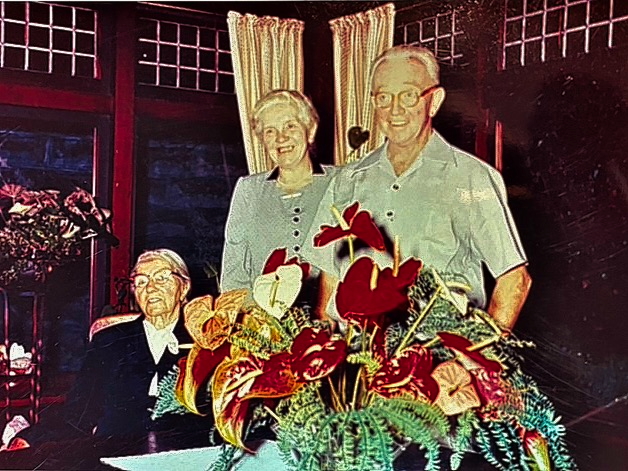
Emma Schmitz, Hedwig and Helmuth at Sans Souci.
As a young man, my grandfather, Eugen, oversaw keeping the estate’s water system running, and the San Souci yacht and equipment etc., in good repair, as well as everything in the home.
There was a big outbuilding we called the shed where all the tools were kept. I remember a large grinding stone used to sharpen tools, many big saws and other tools. He was an engineer of sorts and inspired his wife’s brother, Donald W. Close to become the marvelous electrical engineer he became. Eugen left Seattle only briefly to live in Toledo but returned when they experienced anti-German prejudice. They then lived in a home that was gifted to him by Ferdinand and Emma, the former care-taker’s house just south of the estate, where his 3 children were born.
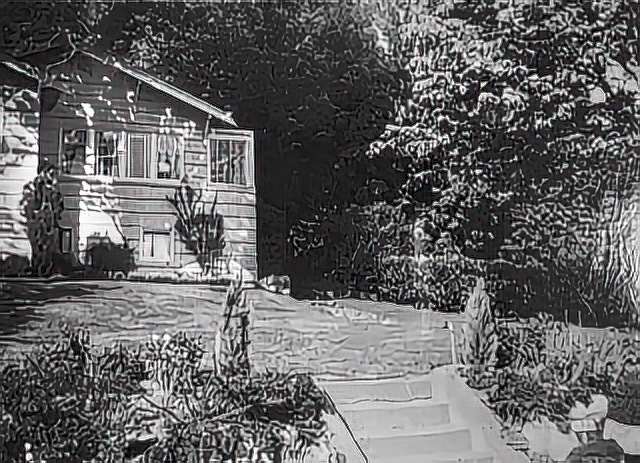
The original care taker’s cottage at 4622 57th SW.
He died an early death leaving a widow, and children and wife, Frankie She singly raised those 3 through college at the UW and had a successful career as a teacher, Personnel Director at the Bon Marche’ department store and personnel director at Children’s Hospital, eventually retiring to a home built next door to my folks’ house, which was also former Schmitz property, sold to them at a very good price.
it was due to the generosity and spirit of Ferdinand and Emma that all these generations have flourished. Their grandchildren and great grandchildren are somewhat scattered but myself my brother Ken Fulton and my first cousins, Jackie and Chris Brown, and Karen Schmitz all live in the Seattle area. There are great and great-great grandchildren as well.
My mother, Dietrich’s wife, Peggy and my Grandmother Frankie Schmitz all went to Germany together to visit the relatives still there in the 60’s and we have kept touch with our relatives in Germany to this day.
My mother and her siblings, Frank & Madelyn were raised here on Beach Drive. When she married, she started her family in that same caretaker’s cottage and moved down the street only when my parents built their home next door to the homestead in the early 50’s. My mother lived the rest of her life there. My 2 brothers and I lived on the beach and roamed the woods and waters our childhoods like our mother and all the Schmitz children. She was active in the Ladies Aid Society in Alki and helped design and implement several of the waterfront parks – Watchweather Park, Constellation Park and others. A quote from my mother in 2003: “We are stewards of the good places and people who have built this community over the years, and we don’t want to forget our roots, so we must continue to feed them.”
As a little girl, I was privileged to be allowed to pick berries and wander the grounds of Emma’s marvelous garden, now part of Mee Kwa Mooks Park and completely overgrown.
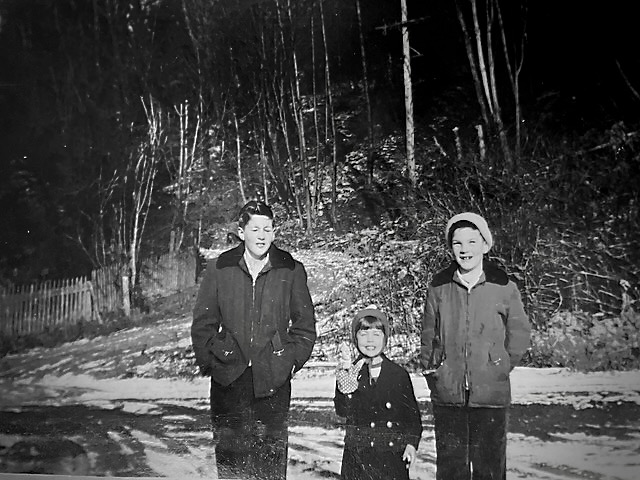
Bill, Gayle and Ken Fulton on Beach Drive at the south entrance of the estate. The picket fence on the left surrounded the garden and estate.
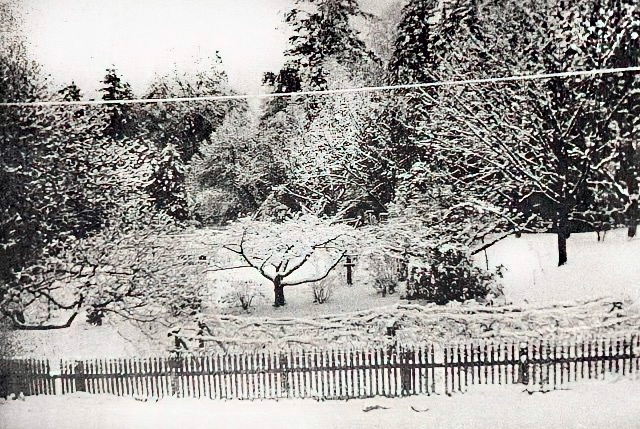
The garden at Sans Souci in winter. The berry trellis is in the foreground, at SW Oregon Street. Note the wide variety of trees both ornamental and fruit bearing.
also liked to visit my Tante Schmitz often in the big house. Just the two of us. There was a big south facing window in the home where she had all of her houseplants (90 at one time!) and a window seat along the entire length of the room. I always loved the Cougar skin from a cougar hunted in our woods. There was a big porch on the front of the house with a large bell used to call the children to meals.
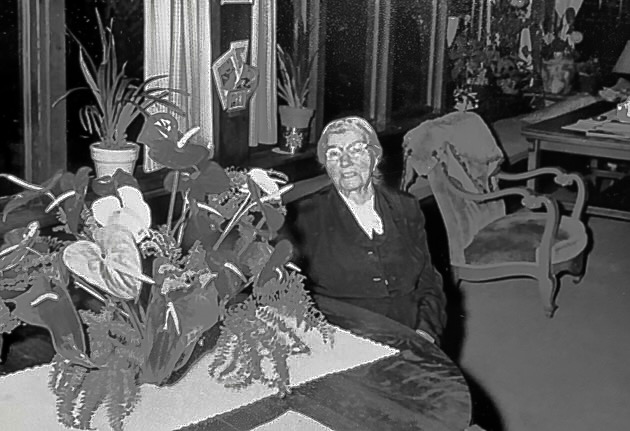
Emma Schmitz at home circa 1962. Note the cougar skin draped over the chair, a product of Ferdinand’s hunting prowess.
Further south of the big house, there was an orchard on the lot that was between my parents’ home and the caretakers house that had a huge Cherry tree and several apple and pear trees. As children in the neighborhood, we all had our individual perches in that tree with eating rights of all the (Royal Anne) cherries we could reach. We were VERY territorial!
The garden in those days was maintained by Yosha, a Japanese man who rode the Alki bus every day to the estate to care for the garden. There were many vegetables raised for the family to eat. Tante Schmitz always made sauerkraut and pickles in a big crock. I still have her recipe. There were beautiful trees there, a big Chestnut tree whose nuts were roasted, a big Yew whose limbs were so big we could “ride” them up and down and eat the berries, The rhododendrons were much much taller than an adult and were in many colors. I would pick them and make leis for Mother’s Day. There were several colors and styles of camelias (also very tall). All the garden was ALWAYS watered with water from the hillside Springs system. The pond on the South side of the home was a holding pond. The big tank with a ladder on the side of it was on the hillside above the Shed and root cellar. There was another holding tank just above the pond in the garden. The pond was circular and there was a circular island in the middle of it with a small arched bridge to it. It was always planted with daffodils that bloomed around Easter. The picture of the Schmitz twins, Nancy and Patsy, was taken for the Easter Sunday edition of the Post Intelligencer in 1953 was taken on that island.
We kids spent many, many hours all year around in the woods behind the estate making camps, bushwacking through the nettles, making trails to secret places. One summer, my brothers made a VERY big rope swing high on the hill. I was a tomboy and always trying to keep up with their antics. The swing was a little to “tall” for me to jump up on after you climbed the hill to get a good swing and I ended up falling in the nettles once and getting the breath knocked out of me. It was a miserable night for me. Calamine lotion did not take away the nasty stings! My mother never worried about us in the woods and on the beach, in our rowboat fishing for sole and bullheads and chasing crabs - because she knew the area well from her own childhood. It’s a pity we don’t have that kind of freedom for children these days. It inspires an adventurous spirit.
I was so lucky to have grown up surrounded by Aunts and Uncles nearby. It has always been a privilege to be a part of the Schmitz family.
Gayle Fulton is the Great Grand Niece of Ferdinand and Emma Schmitz and granddaughter of Eugen and Frankie Close Schmitz. Daughter of Robert and JoAn Schmitz Fulton. She now lives in Hansville, Washington.


